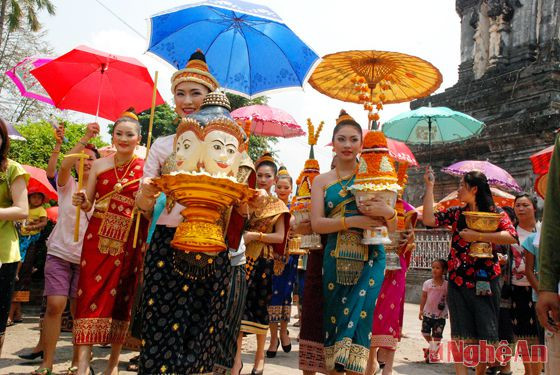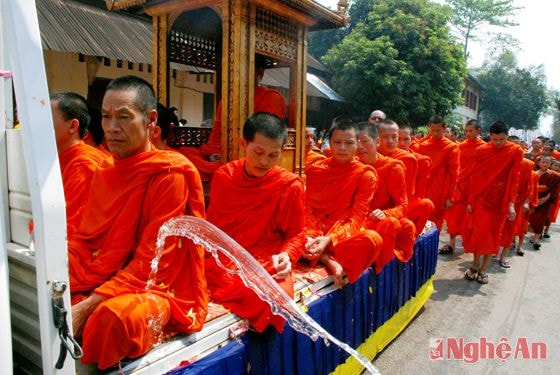Luang Prabang is cheerful and vibrant.
(Baonghean) - “Sa bai di! Xoc di Pi may!” - Hello everyone! Happy New Year! That is the most common greeting that tourists hear throughout Laos during the Water Festival to celebrate the New Year in mid-April every year. However, the strangeness and love will be more complete when tourists come to LuongPrabang - the ancient capital of the Land of a Million Elephants.
Luongprabang is usually quiet but becomes extremely bustling and vibrant in April, the day of Bunpimay - welcoming the new year. The festival takes place from April 14 to 16, but 2 days before the official festival begins, in Luongprabang, everyone is attracted by the beauty contest called Nang Xang Khan. Thousands of young women participate in the contest to find the 7 most beautiful girls. They will be the ones to represent the 7 children of the sky god, Kabinlaphom. Among the beauties, the most outstanding girl will have the honor of riding the lead elephant and lifting the head of the sky god made of plaster. According to custom, the elephant procession carrying the head of the sky god departs from That Pagoda to Xieng Thoong Pagoda. On the long journey of about 1.5 km, people on both sides of the road try to splash water on the procession with the hope of bathing the god Kabinlaphom.
 |
| The Nang Xang Khan (beauty) symbolizes the child of the god of heaven carrying the four-faced statue of her father from Xieng Thoong Pagoda to That Pagoda. |
According to legend, Bunpimay Festival in Laos originated from a battle of wits between the god Kabinlaphom and a wise man named Thammabane. Before the contest, the two sides agreed and made a pact that whoever lost would be executed. And in that battle of wits, the god of the sky lost. Before his death, Kabinlaphom told his seven daughters to guard his head carefully. If it fell to the ground or was thrown into the sky, a disaster would strike. Listening to their father, the seven daughters placed their father's head on a golden plate and took turns washing it every year. This legend is the origin of the Laotian water-splashing custom.
Previously, the New Year's Water Festival was held on the first day of January, but because it was still winter, it was later moved to April, when the weather was hot and Bunpimay was also understood as a rain-praying festival. We still remember a few years ago, when we went to the ancient capital of Luong Prabang on the occasion of the New Year's festival, we were lucky to meet Mr. Bua Nieu, the master of the God's Head Procession Ceremony. He said that the most important thing for the Lao people in general and the residents of Luong Prabang in particular is to preserve the national cultural traditions. The Water Festival is a part of the lives of the Lao people. Today, the legend has become a festival, a unique cultural feature of the residents living along the Mekong River.
 |
| Monks join the procession |
We have been to Laos many times and felt the immense attraction of the festivals and cultural customs. Buddhism was introduced to Laos from India. But before that, in this country, there was a legend of water splashing. The person who brought Buddhism to the Land of a Million Elephants and built it into the national religion was King Chau - Pha - Ngum. And this is also a reason to explain the Laotian water splashing festival moved from January to April according to the Buddhist calendar. And as an obvious thing, the water splashing custom, the New Year festival of the land of pagodas has a colorful blend of spiritual concepts of life and Buddhist ideology.
Back to the main content of the New Year Festival. The starting point of the procession to welcome the head of the God of Heaven starts from That Pagoda to Xieng - Thoong Pagoda, the two oldest pagodas in Laos. On the 1.5 km long journey, the procession has the direct participation of thousands of people. With the diversity and richness of colors and identities, the main ritual of the water festival has created a bustling atmosphere attracting tens of thousands of locals and tourists to worship, watch and splash water to pray for blessings for each other. In the minds of the people of the land of Champa flowers, water brings fulfillment and fullness. For a hot and dry country like Laos, water is not only life, water is culture. In Luongprabang, we were also very lucky to meet the small family of Vo Dai Hiep, a son of the ancient capital of Hue who has become a new citizen of the ancient capital of Luongprabang. Hiep married a native and has a small house with 2 children. Mr. Hiep taught his wife to make banh chung and banh tet for the water-splashing festival. That is also a way for his wife and children to understand Vietnamese culture. That creates cultural exchange in a small family but also solidarity between the two countries of Vietnam and Laos.
An important event to enhance foreign relations and promote tourism cooperation between Central Vietnam and Laos in general; between Laos and Nghe An in particular was that on January 12, 2014, Nghe An province coordinated with the National Airlines (Vietnam Airlines) and the Lao Ministry of Transport to open an international flight route Vinh - Vientiane and vice versa. This is an important condition to narrow the distance from the North Central provinces of Vietnam to famous tourist destinations in Laos, including Luong Prabang. The flight route has brought many conveniences to tourists if they fly from Vinh to the capital Vientiane and will transfer to the beautiful ancient capital of Luong Prabang. That journey now only takes a few hours and tourists will live in a festive atmosphere imbued with nostalgia in one of the most romantic places in the country of Lan Xan.
The gentle character and rich cultural and religious life of Luong Prabang residents have brought a strange attraction and allure to the water festival. Every April, Luong Prabang - a city recognized by UNESCO as a world cultural heritage - is always filled with sounds and joy. Come and feel the vibrant life here during the festival season.
Van Nhi
| Currently, Vietnam Airlines is operating flights from Vinh to Vientiane and vice versa with a frequency of 3 flights/week. Every Wednesday, Friday and Sunday. Departing from Vinh to Vientiane at 8:15 am, and departing from Vientiane to Vinh at 10:15 am. From Vientiane, visitors can travel by road or air to Luong Prabang. With a distance of 450 km, if traveling by road, it will take about 6 - 7 hours. And by air, it will only take about 45 minutes. |






